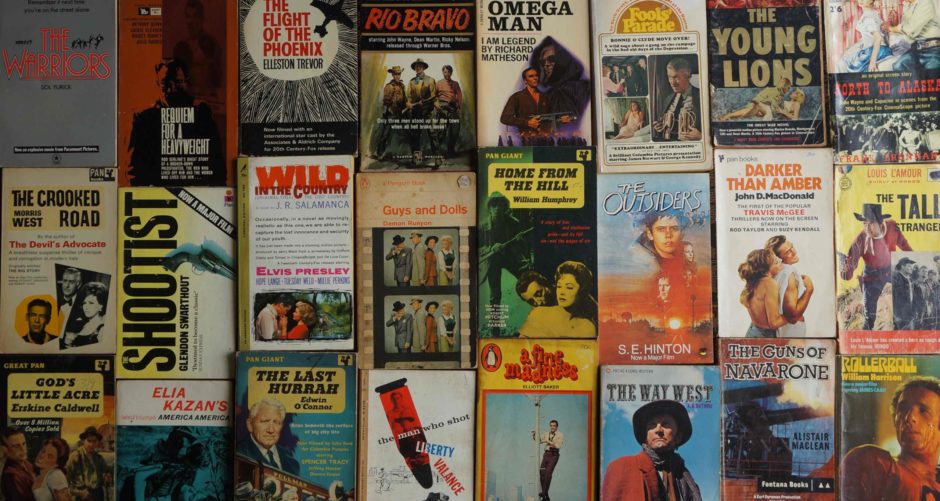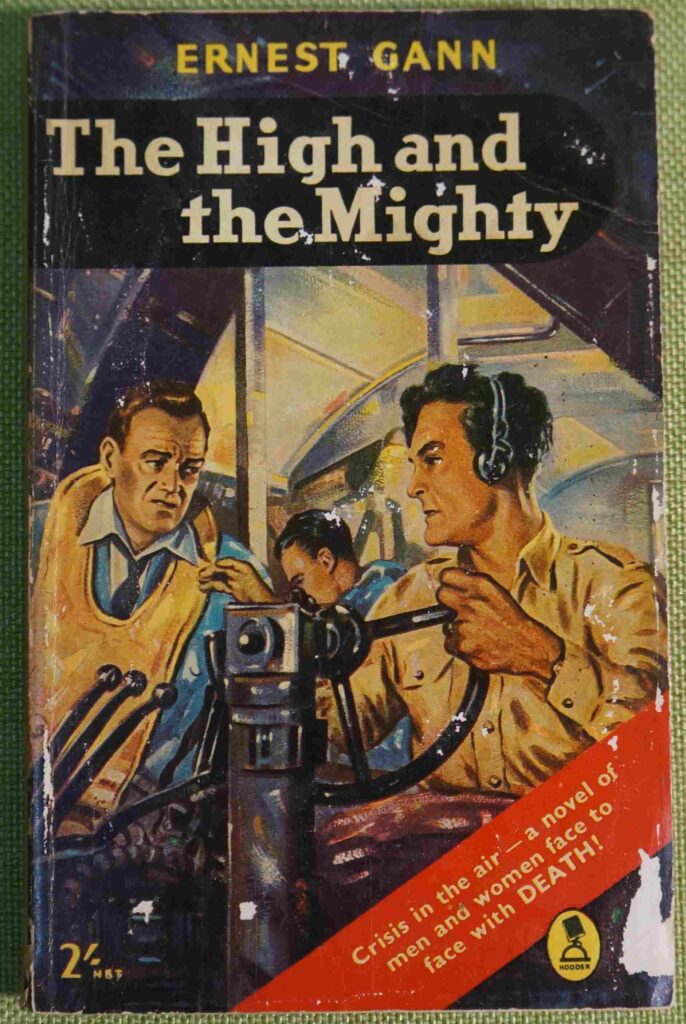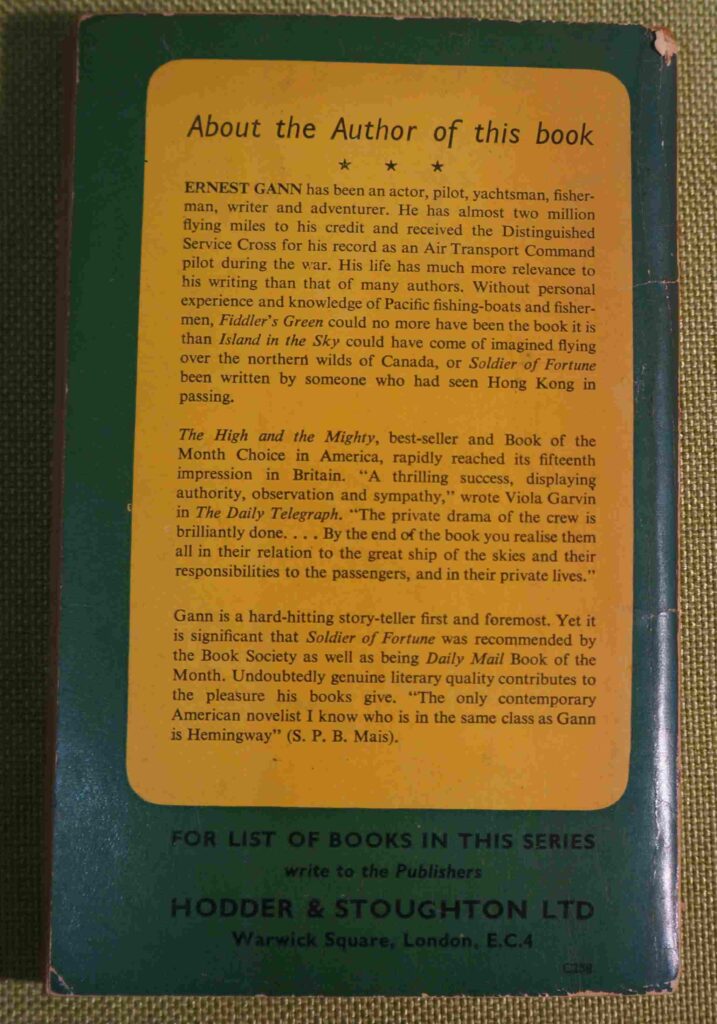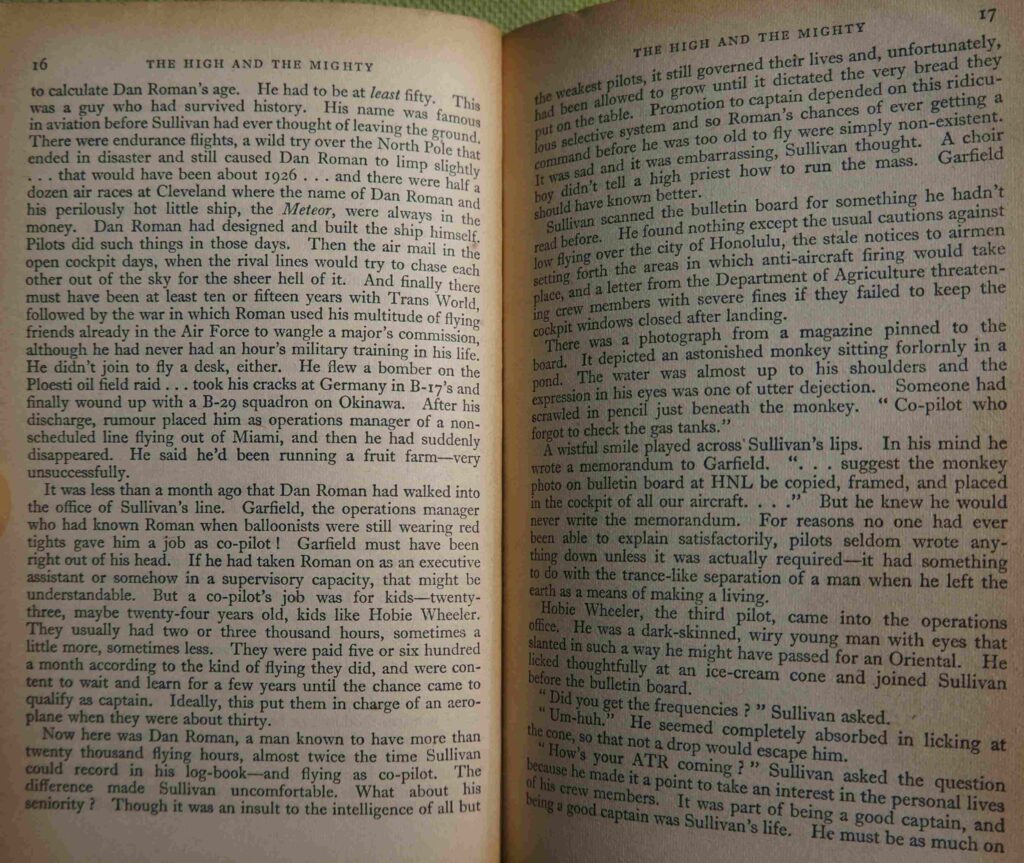THE FILM
FILM DIRECTOR: William A. Wellman
SCREENWRITER: Ernest K. Gann
FILM STARS: John Wayne, Claire Trevor, Laraine Day, Robert Stack, Jan Sterling, Phil Harris, Ann Doran, Robert Newton, David Brian, Paul Kelly, Sidney Blackmer, Julie Bishop, Pedro Gonzalez Gonzalez, John Howard, Wally Brown, William Campbell, John Qualen, Paul Fix, George Chandler, Douglas Fowley, Regis Toomey, Carl “Alfalfa” Switzer, William Hopper, William Schallert, Doe Avedon, Karen Sharpe, John Smith
COUNTRY: USA
THIS BOOK
AUTHOR: Ernest K. Gann
TYPE: Novel
PUBLISHER: Hodder
THIS EDITION PUBLISHED: 1956
COUNTRY: Great Britain
COVER: Paperback
THE ORIGINAL BOOK
ORIGINAL AUTHOR: As Above
YEAR FIRST PUBLISHED: 1953
ORIGINAL BOOK TITLE: The film title
NOTES
GENRE: Disaster
WORDS: This will be a long haul …
The film was, for many years, unseen. It was owned by Batjac, John Wayne’s own production company co-founded by him (and Robert Fellows) for him to both produce and star in movies. Most production companies formed by stars are done so they can star in (or produce) films they want to be made, do roles they don’t get offered much, make more money, or all of the above. Originally called Wayne/Fellows Productions Wayne renamed the corporation after a fictitious trading company mentioned in his film Wake of the Red Witch (1948) though in the movie it was spelled Batjak (Wayne’s secretary misspelled it as Batjac on the corporation papers, and Wayne let it stand). The first Batjac production was Big Jim McLain (1952) released by Warner Brothers. Many of John Wayne’s subsequent films were produced by Batjac who also produced films for stars other than Wayne.
Wayne’s company certainly produced westerns for him (especially later) but also put him into action, adventure and cop movies as well as a pair of films with him as a pilot, the modest hit and Island in the Sky (1953) and this film which was a big smash at the box office (the sixth most popular film of the year in North America).
Most of the Batjac films in the 50s were released by Warner Brothers, meaning there was money in them, and you could see it on the screen (I wish I saw it on the big screen). This is A budget filming 1950s style.
All the films, Wayne’s and one starring other actors, are all superior entertainments. They are well made action and adventure films which are quite literate within the confines of their genres.
Why all this talk?
Well for many years The High and the Mighty was a “lost film”
I recall only twenty or so years ago VHS copies (taped from TV in the 70s I assume) exchanging hands for $70 or $80 US … and apparently the quality wasn’t all that good. I might be a John Wayne fan (and I am) but I wasn’t going to pay that (all the more reason to read the source novel, which I did)
The film was ‘lost” because of a production/distribution deal with Warner Bros giving Batjac the rights to three Wayne films — The High and the Mighty (1954), Hondo (1953), Island in the Sky (1953). McLintock! (1963), distributed by United Artists and produced by Batjac was another “lost” film. Batjac also held full copyright ownership in several non-Wayne movies which were considered lost – Seven Men from Now, Man in the Vault (1956), Ring of Fear (1954), Plunder of the Sun (1953), Track of the Cat (1954), China Doll (1958), Escort West (1958), and Gun the Man Down (1956).
Batjac, not being a major studio, didn’t have the means to actively re-release the films quickly which means the films weren’t on TV much and weren’t released during the initial video craze or the initial DVD craze when all the big companies were racing to get old product out.
That doesn’t mean they didn’t want to, they just had less resources and had to do deals to get the films out, which meant delays.
“After Wayne’s death in 1979, his son Michael Wayne gained full ownership and managed the company until he died in 2003. He meticulously managed the release pattern of his father’s films and restored Hondo and McLintock! in the early 1990s for release on VHS and television. His passion was to restore the other two films, but water damage to the original elements made it impossible during his lifetime. Taking advantage of the new digital restoration processes, Michael’s widow Gretchen restored these films in 2004 and released them through a distribution deal with Paramount Pictures in 2005” https://en.wikipedia.org/wiki/Batjac_Productions
Once they were remastered and released on DVD I was excited but had some trepidation. After waiting for something for a long time will it meet my expectations, will my excitement look over the films flaws or will I be let down?
I recall on first seeing the High and the Mighty and I was not let down though it is not without some minor flaws.
Because it had been out of action many critics (like Leonard Maltin in his seminal annual books “Leonard Maltin’s Movie Guide”) recall it from their youth and praise it, not having seen it as an adult they probably forgot its flaws. Leonard probably did not second guess himself as he would do a documentary on the film that came with its initial DVD release.
I say all this, but in reality the flaws are minor.
This is superior soap with action sequences.
The film about a plane load of passengers in danger is a trope but this film invented the trope. This is the first of the “Airport” type films, the grandfather of the “can the plane make it back to earth safely” story. Here, as per the requirements of the subgenre all the characters on the plane flying between Honolulu and San Francisco have their back stories, and they react differently to the catastrophic engine failure event. It’s up to the pilots, including co-pilot Wayne who has his own demons (as a result of an earlier air crash he was a pilot on that also killed his wife and child) to overcome the obstacles. The beauty here is that being a DC-4 with 17 passengers and a crew of 5 just about all the characters’ back stories can be explored. By the time we got to the Airport films with their 707s and 727s and crew and passengers in the hundreds this was no longer possible so they would pick out a cross section to drive, as they do here, the human element of the narrative.
This is a mixed blessing. The film’s only noticeable flaw (if it is a flaw) are the many flashbacks which are surprising (given the director is William Wellman who likes zip and action), and which slow down the action and increase the running time. Having said that they increase the “human element” and soap qualities (there is also some speechifying and religious symbolism) of the film making it, as it was called by some critics at the time, the “Grand Hotel in the sky”, referring to the famous 1932 film soap opera Grand Hotel whose many characters, with many stories intersect at a hotel in Berlin. Some of the flashbacks in The High and the Mighty are a little hokey but necessary (it’s interesting to think what would have happened if superior soap director Douglas Sirk directed this film).
But there is a fair bit of action. Perhaps a better name for it would have been “Stagecoach in the air” … referring to the John Wayne John Ford film from 1939 – a small group of characters, with different stories in a confined mobile space facing an external threat.
It’s a thoroughly entertaining film and Wayne is wholly convincing (though he never liked his performance, and only did it when they couldn’t get Spencer Tracy for the role) as the tortured though professional pilot. There are so many good bits with Wayne – as he snaps at pilot Robert Stack or comforts the passengers. His mannerisms and asides are gold but all the cast are great, especially Wayne’s co-star from Stagecoach and Allegheny Uprising (both 1939) Claire Trevor (in a role turned down by Barbara Stanwyck who thought the role was too small). Trevor was nominated for the best supporting actress oscar (as was co-star Jan Sterling who is excellent) … neither won. Also, anything with William Campbell has to be good (his role is bigger than his cast position would suggest) and it’s good to see Laraine Day, Robert Stack (who parodies this sub genre later in Flying High (1980)), scenery chewing Robert Newton, future TV star (Laramie) and John Wayne co-star (Circus World (1964)) John Smith in a small support, the babaceous Karen Sharpe and Doe Avedon, and John Wayne friends Pedro Gonzales Gonzales, John Qualen, and Paul Fix in roles.
Director William Wellman (himself an ex-pilot) made quite a few aviation films and had already made Island in the Sky (1953) with John Wayne (who played an army pilot on a transport plane) which was also based on a novel by Gann. That film was a modest but effective, black and white film about men fighting the elements after crash landing. Here he shows what he can do with a lot of dialogue. The film is long and for the most part limited to a plane but it’s a hoot. The characters riff off each other but there is no doubting the central story is Wayne’s.
Legendary composer Dimitri Tiomkin scored the film and composed the theme song “The High and the Mighty”. The song was also called “The Whistling Song” because John Wayne whistled the tune during the film. Tiomkin’s music topped hit parade charts and remained there for weeks, increasing the film’s profile. He also won an Academy Award for his original score, while the title song for the film also was nominated for an Oscar.
The song has become an exotica standard. The first release of the title tune was by Leroy Holmes and His Orchestra (Whistling by Fred Lowery) in 1954 released even before the version by Dimitri Tiomkin and His Orchestra. Many versions (80+) have been done since by all the usual orchestra leaders, Marty Gold, Franck Pourcel, Les Baxter, as well as combos headed by Arthur Lyman, Jimmy Smith and instrumentalists like Roger Williams, Ferrante & Teicher and the Shadows. There was even a vocal version released with lyrics by Ned Washington. The tune was just that catchy. For me, one of the best versions is Los Indios Tabajaras from 1966.
The film was a big hit at the time and solidified Wayne’s run at the top as a #1 box office star (and it has to be remembered that Wayne was in the Top 10 from 1949 – 1974 and in the 50s, when he was at his peak, he made relatively few westerns ( 5 out of 19)).
A long time prior to seeing the film I had read the book. I found the book in an op shop and though it doesn’t mention the film specifically (as you can tell from the cover) it’s pretty clear John Wayne and Robert Stack are depicted. I bought it and read it immediately. I loved it and it kicked off my reading anything by Ernest K. Gann. Gann was an interesting character … a pilot (commercial, army transport, and private), and a sailor, and he wrote about both. He had a Hemingwayesque style with action and philosophising. His characters are more than one dimensional and there are whole passages of prose that read like poetry (with a touch of melancholy and memory in a Rod McKuen-esque way – and that’ a good thing) which is all anchored by a generous amount of technical detail for fiction (which doesn’t get in the way of the story (or screenplay which he also wrote)), so much so that after having read his books, you feel like you could fly a plane or captain a boat. Its been awhile since I read the novel but I recall the suspense and action not being overshadowed by the whys and hows of flying a plane in potentially disastrous circumstances.
It is a thoroughly entertaining read.
See the film, read the book.
PAGES
LINKS
TRAILER
MUSIC
Les Baxter title theme song (cover) – 1954
Los Indios Tabajaras title theme song (cover) – 1965




yep re Kirk … no one pushes Kirk around. His Bryna Production Company was involved with (partially funded) POG ..and…